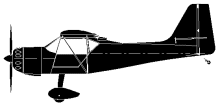
ASN Wikibase Occurrence # 286827
This information is added by users of ASN. Neither ASN nor the Flight Safety Foundation are responsible for the completeness or correctness of this information.
If you feel this information is incomplete or incorrect, you can submit corrected information.
| Date: | Tuesday 7 July 2009 |
| Time: | 11:30 LT |
| Type: |  Kitfox |
| Owner/operator: | |
| Registration: | N926JB |
| MSN: | KBS 079 |
| Total airframe hrs: | 278 hours |
| Engine model: | Rotax 912UL |
| Fatalities: | Fatalities: 0 / Occupants: 2 |
| Aircraft damage: | Substantial |
| Category: | Accident |
| Location: | Valencia, California -
 United States of America United States of America
|
| Phase: | En route |
| Nature: | Training |
| Departure airport: | Los Angeles-Whiteman Airport, CA (WHP/KWHP) |
| Los Angeles-Whiteman Airport, CA (WHP/KWHP) | |
| Investigating agency: | NTSB |
| Confidence Rating: |
The pilot reported that he was flying back to the airport when the experimental airplane began to shake violently, which was accompanied by a loud noise. The propeller blades departed the airplane and the engine subsequently experienced an overspeed, followed by a loss of power. During a forced landing, the airplane encountered a ditch and spun 90 degrees. Metallurgical examinations of the blades could not determine the method of failure. Tests and calculations indicate that the engine could not rotate fast enough to liberate the blades unless their strength had been degraded in some way. Several possible sources of such degradation were observed, but none of them could be conclusively identified as the cause of the event. The strength of the blades was provided by the wood of the propeller, and the fractures in the wood of the three blades appeared similar, making no obvious difference to identify the initial separation. The blades were found very close to one another, suggesting that they were liberated at nearly the same point of rotation during a single revolution of the propeller. Assuming one blade had accumulated enough damage to initiate the event, the resulting unbalanced vibration was sufficient to eject the other two blades, in the process creating fractures similar to those on the damaged blade. The measured gap between hub halves was less than the expected gap for new, correctly installed blades. Such over-clamping of the hub is one problem that has apparently occurred in the past due to improper torquing. It is possible that the hub had previously been over-clamped to a greater degree, with subsequent adjustment leading to an under-clamped condition. Looseness in this area can lead to fatigue cracking, because it allows for the variations in stresses from repetitive loads to be maximized on the components being connected. Bird impact was ruled out, but the blade might have been struck by debris picked up during takeoff. Although there was no staining or other signs of degradation in the wood, one blade had an area that was susceptible to moisture due to a manufacturing defect, which could have allowed the decrease in the stiffness and strength of wood structures and may have played a role in liberating the blades.
Probable Cause: The failure and separation of a propeller blade for undetermined reasons.
Accident investigation:
 |
|
Sources:
NTSB WPR09LA340
Location
Revision history:
| Date/time | Contributor | Updates |
|---|---|---|
| 03-Oct-2022 16:40 | ASN Update Bot | Added |
Corrections or additions? ... Edit this accident description
The Aviation Safety Network is an exclusive service provided by:


 ©2024 Flight Safety Foundation
©2024 Flight Safety Foundation